Oklahoma, known to us as the “Sooner State,” has a vibrant fossil record that spans all three eras of the Paleozoic, Mesozoic, and Cenozoic, about 300 million years ago. The sea covered all of the state—from the Cambrian to the Devonian. The sea was home to numerous creatures, including trilobites, graptolites, bryozoans, and brachiopods.
The sea withdrew during the Permian period, and the Sooner State was dry throughout the Mesozoic but was later covered by the Western Interior Seaway during the Cretaceous period. The state was home to creatures like horses, creodonts, camels, and bison during the Cenozoic.
During the Ice Age, Oklahoma was home to mastodons and mammoths. Read on for more information about Oklahoma’s prehistoric animals that went extinct several years ago.
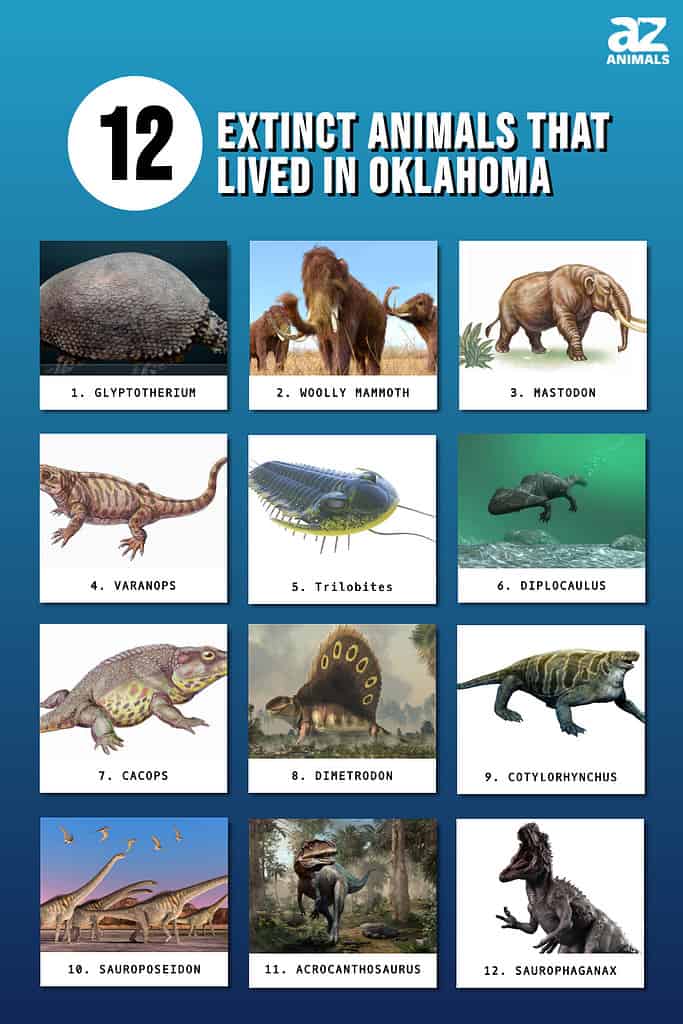
12 Extinct Animals That Lived in Oklahoma
Oklahoma was once home to many prehistoric reptiles and megafauna mammals, whose existence probably coincided with the arrival of humans. The following are some of the extinct animals that called the Sooner State home.
1. Glyptotherium
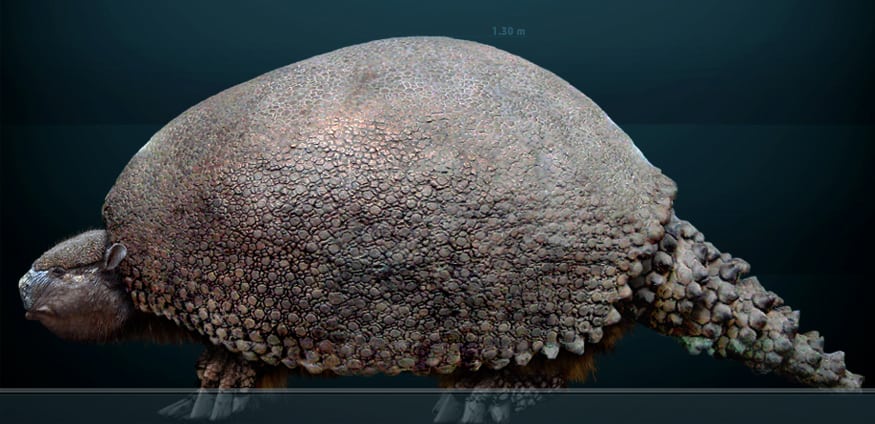
Glyptotherium is considered an example of Oklahoma’s megafauna.
©Sergiodlarosa / CC BY-SA 4.0 – License
| Glyptotherium | |
|---|---|
| Kingdom | Animalia |
| Phylum | Chordata |
| Class | Mammalia |
| Order | Cingulata |
| Family | Chlamyphoridae |
| Subfamily | Glyptodontinae |
| Species | Glyptotherium |
| Living period | Early Pliocene to Early Holocene- 1.8 million to about 7,000 years ago |
Glyptotherium is an extinct group of massive, graviportal, herbivorous armadillos that belong to the genus Glytodont. They lived from 1.8 million years ago (Early Pliocene) to about 7,000 years ago (Early Holocene). Glyptotherium is considered an example of Oklahoma’s megafauna. Paleontologists have discovered many Glyptotherium fossils within the state.
These species had a shell covering their torso and armor on their skulls, similar to turtles. They had short limbs, hypsodont teeth, and pelves fused to their armored carapaces. The armor protected the Glyptotherium from predators like the saber-toothed cat and Arctotherium, the giant bear.
2. Woolly Mammoth
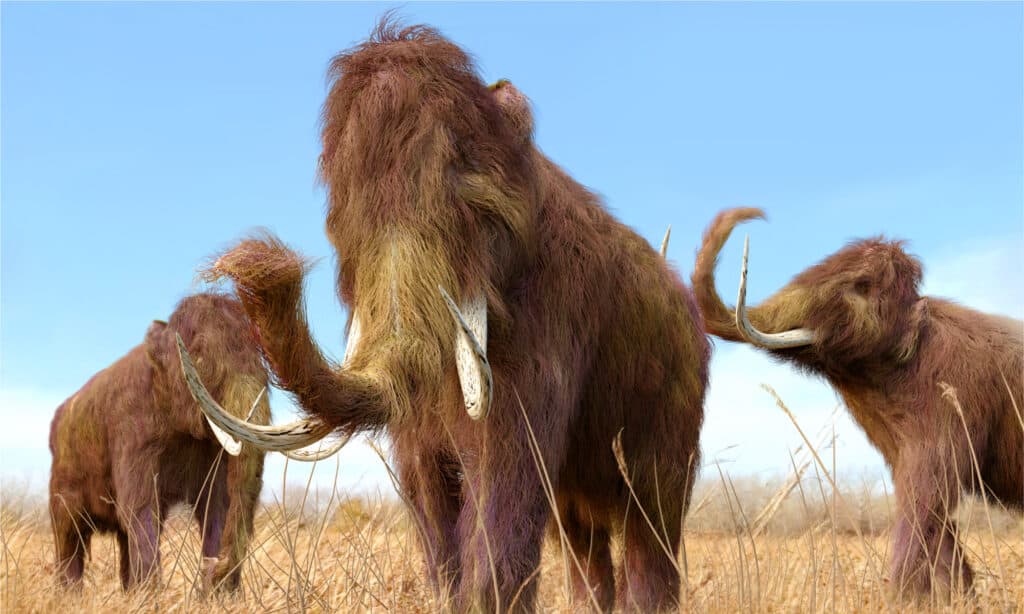
The woolly mammoth is an extinct mammoth species that lived during the Pleistocene.
©Aunt Spray/Shutterstock.com
| Woolly Mammoth | |
|---|---|
| Kingdom | Animalia |
| Phylum | Chordata |
| Class | Mammalia |
| Order | Proboscidea |
| Family | Elephantidae |
| Genus | Mammuthus |
| Species | Mammuthus primigenius |
| Extinct since | 37,000 years ago |
The woolly mammoths traversed the vast plains of Oklahoma. Access Midstream workers discovered their remains while installing a high-pressure natural gas line northwest of Enid. Paleontologists, including Oklahoma University students, helped excavate the remains of this prehistoric animal. According to the researchers, the mammoth was about 50,000 years old.
Scientifically known as Mammuthus primigenius, the woolly mammoth is an extinct mammoth species that lived during the Pleistocene. It went extinct about 37,000 years ago and was the last in the line of mammoth species. It had long curved tusks and measured up to 11 feet high at the shoulder. Females weighed 8,000 pounds, while males weighed about 12,000 pounds. Genetic tests revealed that this species ranged in color from dark brown to blonde or black.
3. Mastodon
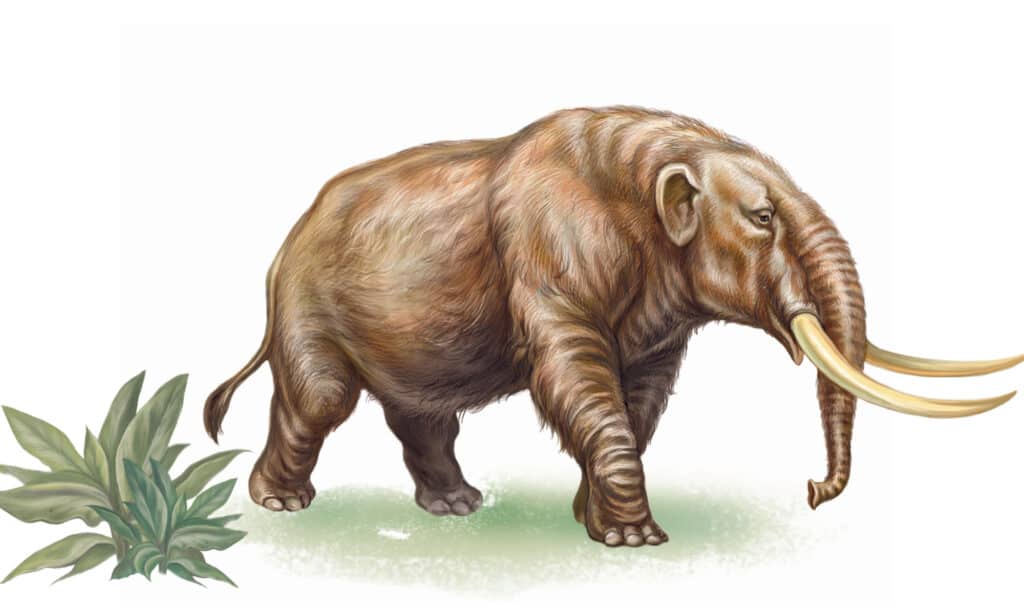
Mastodons lived either during the late Miocene or late Pliocene.
©Liliya Butenko/Shutterstock.com
| Mastodon | |
|---|---|
| Kingdom | Animalia |
| Phylum | Chordata |
| Class | Mammalia |
| Order | Proboscidea |
| Family | Mammutidae |
| Genus | Mammut |
| Living period | Late Miocene or late Pliocene – 11,000 years ago |
Oklahoma was home to mastodons during the Ice Age, about 2.6 million to 11,700 years ago. Granite residents discovered a mastodon’s teeth, tusk, and femur many years ago. Like the woolly mammoths, mastodons also belong to the genus Mammuth. Mastodons lived either during the late Miocene or late Pliocene and became extinct at the end of the Pleistocene, about 10,000 to 11,000 years ago.
This species resembled the woolly mammoths, though mastodons were shorter and stockier and had shorter and straighter tusks than other mammoths. Besides, mastodon molars had pointed cones, probably an adaptation for eating woody browse, while mammoths had molas with flat surfaces for eating grass.
4. Varanops
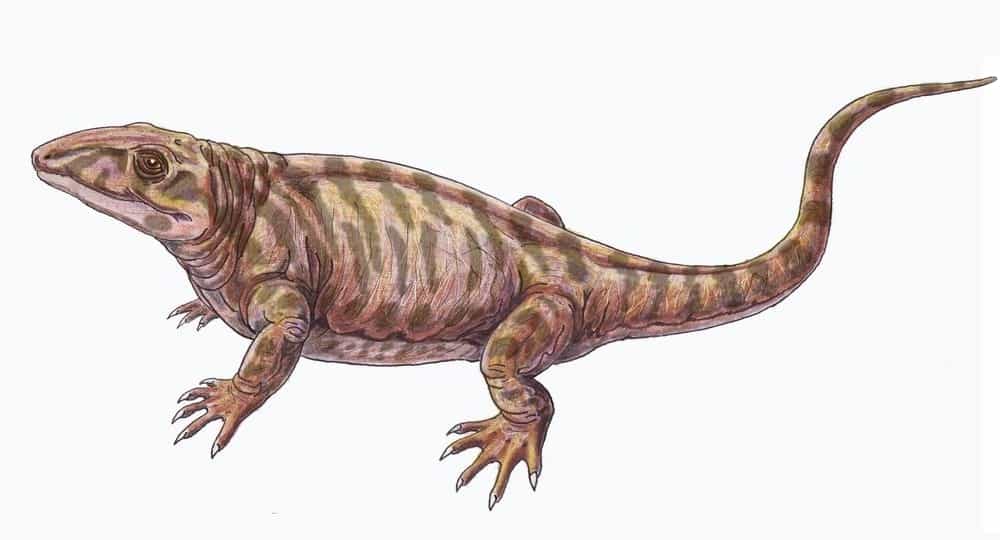
Varanops is an extinct species of the genus Pelycosaur.
©ДиБгд / public domain – License
| Varanops | |
|---|---|
| Kingdom | Animalia |
| Phylum | Chordata |
| Family | Varanopidae |
| Subfamily | Varanopinae |
| Genus | Varanops |
| Species | Varanops brevirostris |
| Living period | Early Kungurian stage of the Cisuralian Epoch, approximately 279 and 272 million years ago |
Varanops is an extinct species of the genus Pelycosaur. It was a large animal, about the size of a modern monitor lizard. It measured approximately 3.9 feet long, with sharp, backward-curved teeth and large limbs. Of all the pelycosaurs, Varanops was the most agile and voracious reptile. Varanops was small compared to dinosaurs that came much later, though it was large for its time.
Varanops played a significant role in being one of the last species of its family on the planet, dating to the early Kungurian stage of the Cisuralian Epoch, between 279 and 272 million years ago. All the pelycosaurs on earth had gone extinct by the start of the Triassic period, about 10 million years ago. The Early Permian varanopid synapsids were first discovered and named in the US states of Oklahoma and Texas.
5. Trilobites

Trilobites lived throughout the lower Paleozoic and started declining in the Devonian.
©SciePro/Shutterstock.com
| Trilobites | |
|---|---|
| Kingdom | Animalia |
| Phylum | Arthropoda |
| Clade | Arachnomorpha |
| Subphylum | Trilobitomorpha |
| Class | Trilobita |
| Living period | 521-252 million years ago |
Trilobites are extinct marine arthropods that belong to the class Trilobita. They lived throughout the lower Paleozoic and started declining in the Devonian. The last species of trilobites finally died out at the end of the Permian, about 252 million years ago. Of all the early animals, trilobites were the most successful, thriving in the oceans for approximately 270 million years and with over 20,000 species. Exactly why the trilobites became extinct remains unclear. The Devonian Haragan Formation in Oklahoma is one of the ideal locations to find all the history surrounding trilobites and other marine arthropods.
6. Diplocaulus
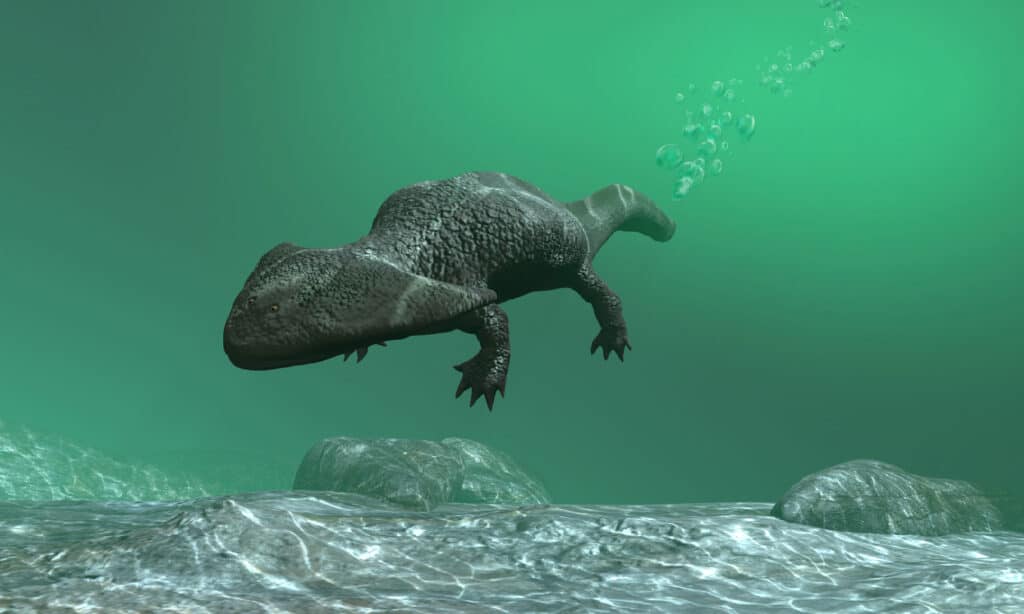
Diplocaulus lived from the Late Carboniferous to the Late Permian of Africa and North America.
©iStock.com/estt
| Diplocaulus | |
|---|---|
| Kingdom | Animalia |
| Phylum | Chordata |
| Subclass | Lepospondyli |
| Order | Nectridea |
| Family | Diplocaulidae |
| Genus | Diplocaulus |
| Living period | Late Carboniferous to the Late Permian- approximately 270 million years ago |
Diplocaulus is the largest and best-known extinct amphibian of the genus Lepospondyl. It had a stocky, salamander-like body that measured about 3.3 feet long and had some long horn-like protrusions at the rear end of the skull. Remains associated with this bizarre, boomerang-shaped species have been found all over the state of Oklahoma. They lived from the Late Carboniferous to the Late Permian of Africa and North America.
7. Cacops

According to researchers, Cacops hunted at night to avoid larger amphibian predators in the Sooner State’s habitat.
©Dmitry Bogdanov / CC BY 3.0 – License
| Cacops | |
|---|---|
| Kingdom | Animalia |
| Phylum | Chordata |
| Class | Amphibia |
| Order | Temnospondyli |
| Family | Dissorophidae |
| Clade | Eucacopinae |
| Genus | Cacops |
| Living period | Early Permian, about 290 million years ago |
Cacops is one of the extinct species of the genus Dissorophid temnospondyls. This reptile-like amphibian had a lightly armored back, a short tail, and stubby legs and was equipped with relatively advanced eardrums. Its skull is box-like, with cheeks aligned to it almost at a right angle.
Although Cacop fossils are almost exclusively from the well-known Cacops Bone Bed of the Lower Permian Arroyo Formation in Texas, some remains have also been found in Oklahoma. According to the researchers, Cacops hunted at night to avoid larger amphibian predators in the Sooner State’s habitat. It’s thought that the advanced eardrums were probably an adaptation to life on the Oklahoma dry plains. This species lived in the Early Permian, about 290 million years ago.
8. Dimetrodon
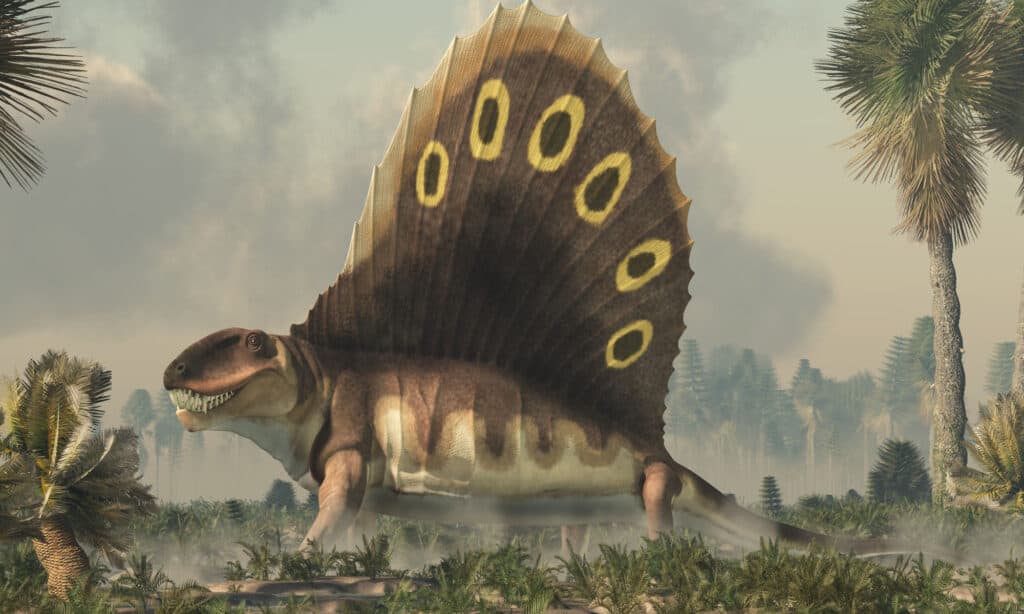
Most Dimetrodon species measured between 6 to 15 feet.]
©Daniel Eskridge/Shutterstock.com
| Dimetrodon | |
|---|---|
| Kingdom | Animalia |
| Phylum | Chordata |
| Clade | Synapsida |
| Family | Sphenacodontidae |
| Subfamily | Sphenacodontinae |
| Genus | Dimetrodon |
| Living period | Early Permian, about 295-272 million years ago |
Dimetrodon is an extinct reptile-like species of the genus non-mammalian synapsid that lived in the Early Permian, about 295-272 million years ago. It’s often mistaken for an actual dinosaur, though it became extinct 40 million years ago, before the appearance of a dinosaur. It had one of the most distinctive large neral spin sails on its back. No one knows the exact function of the unique sail; it may have helped the reptile absorb and dissipate heat or was probably a sexually selected characteristic.
Most Dimetrodon species measured between 6 to 15 feet and were estimated to have weighed approximately 60 to 550 pounds. Dimetrodon fossils have been discovered in some parts of Oklahoma and can be found in the Red Bed Formation shared by Texas and Oklahoma.
9. Cotylorhynchus
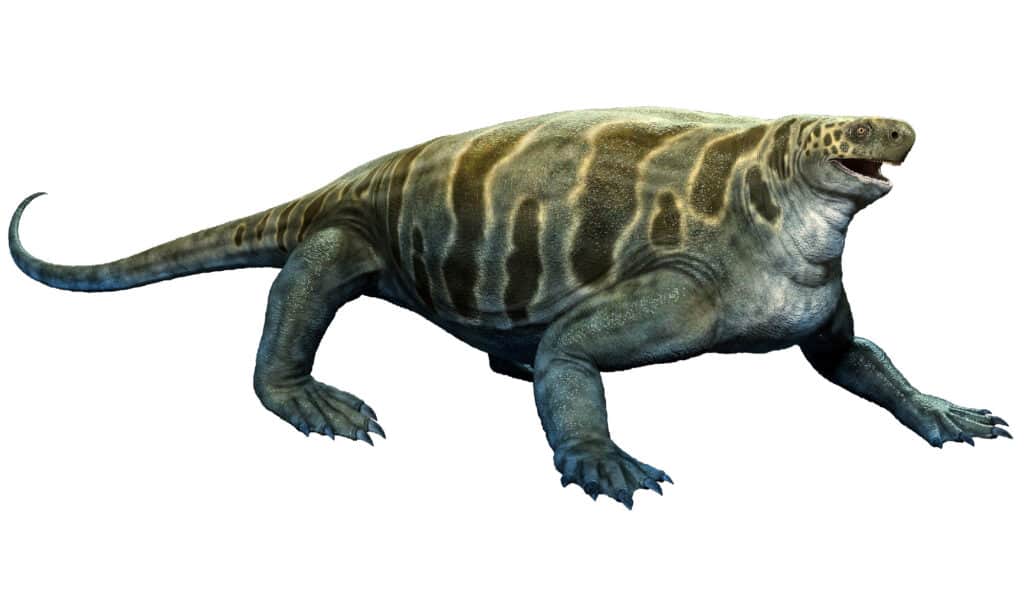
Cotylorhynchus is an extinct species of the synapsid clade Caseidae.
©iStock.com/Warpaintcobra
| Cotylorhynchus | |
|---|---|
| Kingdom | Animalia |
| Phylum | Chordata |
| Clade | Synapsida |
| Clade | Caseasauria |
| Family | Caseidae |
| Genus | Cotylorhynchus |
| Living period | Early Permian to the Late-mid Permian -about 265 million years ago |
Cotylorhynchus is an extinct species of the synapsid clade Caseidae. It was considered a close relative of Dimetrodon and also the largest terrestrial vertebrate of the Early Permian. It had a vast barrel-shaped body, stubby legs, and a disproportionately small head.
Cotylorhynchus grew to a total length of between 14.7 and 15.7 feet, with larger species measuring up to a whopping 20 feet long. Three species of Cotylorhynchus; C. bransoni, C. romeri, and C. hancocki, have been discovered in Oklahoma and Texas.
10. Sauroposeidon
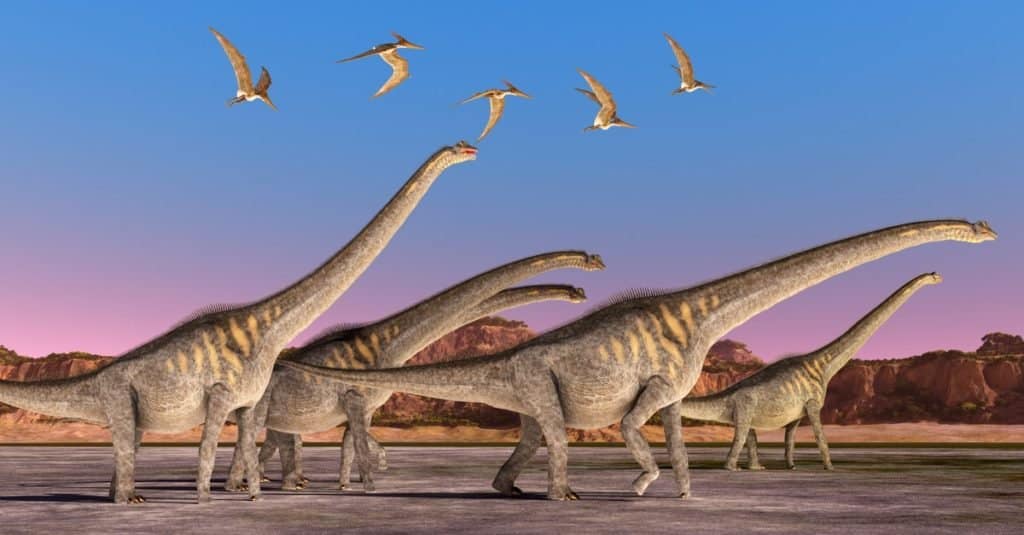
The first Sauroposeidon fossils were discovered in Oklahoma in a claystone outcrop.
©Catmando/Shutterstock.com
| Sauroposeidon | |
|---|---|
| Kingdom | Animalia |
| Phylum | Chordata |
| Clade | Dinosauria |
| Clade | Saurischia |
| Clade | Sauropodomorpha |
| Clade | Sauropoda |
| Clade | Macronaria |
| Clade | Somphospondyli |
| Genus | Sauroposeidon |
| Species | Sauroposeidon proteles |
| Living period | 113 to 110 million years ago |
Sauroposeidon is an extinct species of the genus Sauropod dinosaur. It measured between 54 and 112 feet, with its neck extended, making it one of the tallest dinosaurs. It’s also ranked as the heaviest, with an estimated weight of up to 100 tons. The first Sauroposeidon fossils were discovered in Oklahoma in a claystone outcrop that dates the remains to about 110 million years ago, a time when Sauroposeidon diversity had greatly diminished in North America. Bobby Cross, a dog trainer, found the fossils in May 1994 at the Antlers Formation in Atoka County, Oklahoma.
11. Acrocanthosaurus
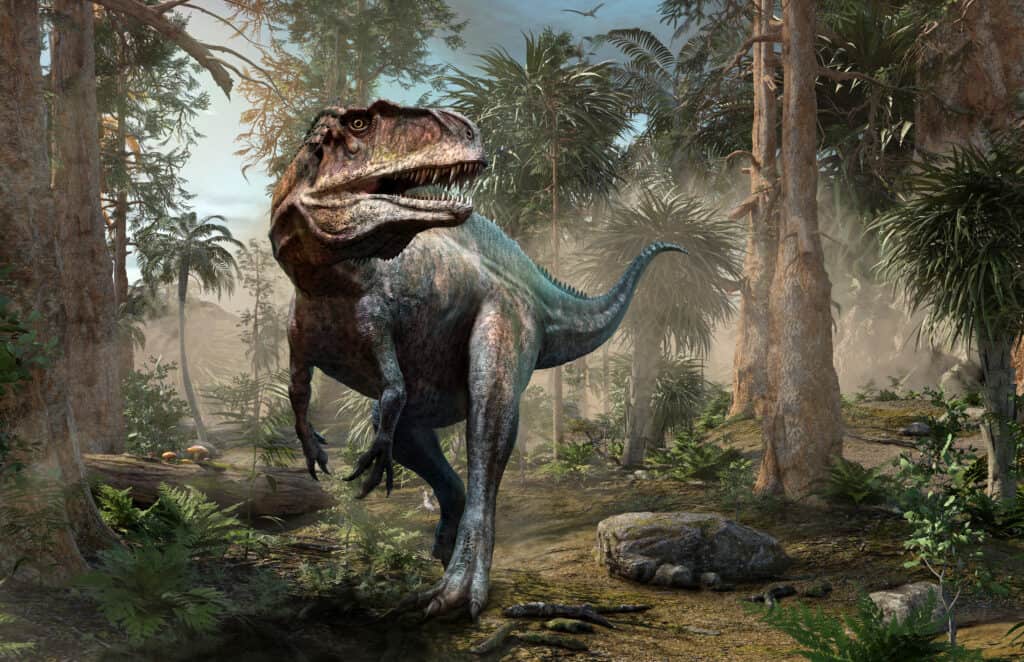
Acrocanthosaurus had a long, narrow skull like most allosaurids.
©Warpaint/Shutterstock.com
| Acrocanthosaurus | |
|---|---|
| Kingdom | Animalia |
| Phylum | Chordata |
| Clade | Dinosauria |
| Clade | Saurischia |
| Clade | Theropoda |
| Family | Carcharodontosauridae |
| Genus | Acrocanthosaurus |
| Living period | Early Cretaceous period, about 125 million years ago |
Acrocanthosaurus is a high-neural spined lizard of the early Cretaceous period, about 125 million years ago. Its fossils were discovered in Oklahoma shortly after the Second World War. It was the largest theropod known to exist, with an estimated measurement of 38 feet from snout to tail tip, and weighed about 1,000 to 2,000 pounds. Acrocanthosaurus had a long, narrow skull like most allosaurids. Its most prominent features were a row of tall neural spines on the back and a robust leg structure.
12. Saurophaganax
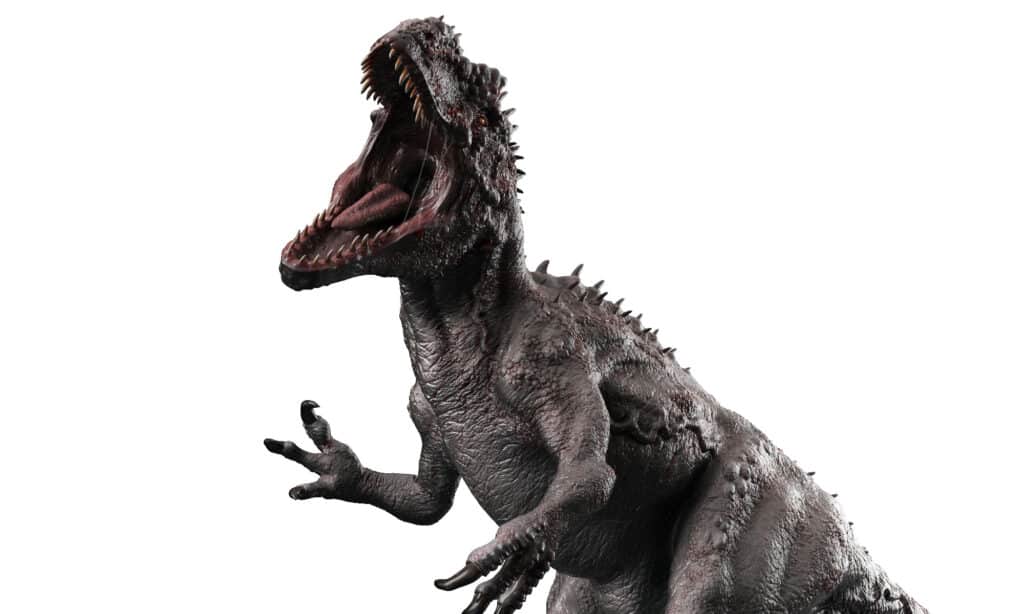
Saurophaganax is also known as the “lord of lizard-eaters.”
©Herschel Hoffmeyer/Shutterstock.com
| Saurophaganax | |
|---|---|
| Kingdom | Animalia |
| Phylum | Chordata |
| Clade | Dinosauria |
| Clade | Saurischia |
| Clade | Theropoda |
| Clade | Allosauria |
| Family | Allosauridae |
| Genus | Saurophaganax |
| Species | Saurophaganax maximus |
| Living period | Latest Kimmeridgian age, about 151 million years ago |
Also known as the “lord of lizard-eaters,” Saurophaganax is the official state dinosaur of Oklahoma from the latest Kimmeridgian age, about 151 million years ago. It’s considered one of the species of Allosaurus with horizontal laminae at the bases and “meat-chopper” chevrons. It measured between 34 and 43 feet in total length and had a maximum average weight of 9,400 pounds.
John Willis Stovall uncovered Saurophaganax remains between 1931 and 1932 near Kenton in Cimarron County, Oklahoma. Its skeleton is on display at the Oklahoma Museum of Natural History.
Summary Of The 12 Extinct Animals That Lived In Oklahoma
| Rank | Animal | Date Lived |
|---|---|---|
| 1 | Glyptotherium | 1.8 million to about 7,000 years ago |
| 2 | Woolly Mammoth | 37,000 years ago |
| 3 | Mastodon | 11,000 years ago |
| 4 | Varanops | approximately 279 and 272 million years ago |
| 5 | Trilobites | 521-252 million years ago |
| 6 | Diplocaulus | approximately 270 million years ago |
| 7 | Cacops | about 290 million years ago |
| 8 | Dimetrodon | about 295-272 million years ago |
| 9 | Cotylorhynchus | about 265 million years ago |
| 10 | Sauroposeidon | 113 to 110 million years ago |
| 11 | Acrocanthosaurus | about 125 million years ago |
| 12 | Saurophaganax | about 151 million years ago |
The photo featured at the top of this post is © Liliya Butenko/Shutterstock.com
Thank you for reading! Have some feedback for us? Contact the AZ Animals editorial team.






